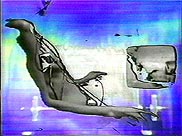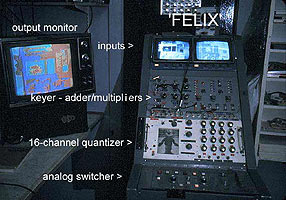FELIX - VIDEOSYNTHESIZERCreated by Al Razutis and Jim Armstrong - 1974-1976
Brief Chronology:In 1971-2 (Al) Razutis was employed at Evergreen State College (Olympia, Washington) as a 'Visiting Faculty Member' and it was there that he, in collaboration with a number of his students, began to experiment with color video synthesis (videofeedback, combination of film and video, audio modulation of video signal) which would result in a number of 'videosynthesis' tapes by Razutis as well as 'Videographics' and hybrid films such as Vortex - the synthesizer was created between 1972 - 1976. These works by Razutis (in color) represented a departure from his earlier experiments with black & white 1/2" video (Sony Portapak and AV 3650 editor) conducted in the late 60's-early 70's with Intermedia (Vancouver) equipment and facilities. Continuing through 1974 when Razutis (and Gary Lee Nova) re-visited the Evergreen campus, a number of bio-feedback, video-feedback, film and video 'hybrid' experiments were created by Razutis, Lee-Nova, and students/ex-students of Evergreen State College and Portland Community College. These early experiments, which sought to extend the capabilities of video to incorporate audio-synthesis (Arp, Buchla, Moog synthesizer) mixing techniques, with modulation of the video signal (through Beckman EEG outputs and human stimulation) and the combination of motion picture (16mm) film and video processes ('Hybrids' - which featured video transfered to film or film to video) resulted in a body of works and the preliminary designs for the future 'Felix' video synthesizer. In 1974, Razutis secured the circuit diagrams for a 16-channel quantizer created by Colorado Video. These plans were provided by Jim Cox (a previous student at Evergreen). Jerry Barenholtz (Vancouver) contacted Jim Armstrong, a Bellingham based electronics designer, to explore the beginnings of construction of modules for a 'videosynthesizer' to be used in both bio-feedback and film-video hybrid synthesis work on Razutis' projects at Visual Alchemy. During the period of 1974-76, the 'Felix' videosynthesizer was built from custom printed circuit boards (created by Jim Armstrong) which were comprised of 'adder-multipliers' (analog mixers), 'window comparators and keyers'(separate channel keyers), '16-channel quantizer' module (slicing a signal / ramp according to threshold), a switcher - mixer (re-built by Razutis from a Viscount model) and accessory input/output devices (routing) all housed in a large console (provided by Tom Osborne from surplus equipment at St. Paul's Hospital, Vancouver). The overall design and funding was provided by Al Razutis; the modules, circuit boards and components were designed (from available diagrams, from other sources, or original concepts) and constructed by Jim Armstrong. Together, they were responsible for the creation of this device. 
Audio and bio-feedback origins of videosynthesizers / 'Felix' in performance on Vancouver television Video Culture in Vancouver (early 70's):The appearance of the Sony Portapak (1/2" reel-to-reel black & white portable video recorder) and the subsequent appearance of the Sony 3650 and AV 5000 half-inch recording-editing machines in Vancouver - first at Intermedia (Beatty Street, later 4th Avenue) provided the necessary technology to create experimental video 'art'. Some of this technology was used by Intermedia artists - poets (Gerry Gilbert, Don Druick, Razutis, and others) towards the creation of 'video art' tapes. Other access to video technology in the early 70's was provided by after-hours use of BCIT (British Columbia Institute of Technology) video facilities (Gene Lawrence), out of town facilities at Evergreen State College (Olympia, Washington) and Portland Community College (Portland, Oregon) which were frequented by Razutis and Gary Lee-Nova, and later at Cable-10 Vancouver (for program presentations). Upon the collapse of Intermedia, two organizations that began to use video (Western Front, and Video In) were set up in Vancouver. The use of video at the Western Front was in the documentation of performances / events; the use of video at Video In was primarily for social documentary purposes. In both (WF and VI) institutions, the creation of synaesthetic (synthetic - processed) video was frowned upon in the early (70's) days. Of course, these sentiments would later change as video changed. The 'project' of developing videosynthesis (videosynthesizer, synaesthetic video) was occuring at Visual Alchemy (Razutis' studio) in conjunction with his other activities in film effects, holography, animation. The aesthetic 'differences' between these approaches to video resulted in adversarial and hostile exchanges. The artists at the Western Front made it 'clear' that to them the use of synthetic video was a 'technical trick' and as such was unrelated to a 'aesthetic' use of the medium. Years later, both institutions (Western Front and Video In) would invest heavily in video processing, compositing, FX technologies, at the expense of the taxpayer and grant subsidies, since it would become obvious that this use of video was becoming 'mainstream'. Web page on Intermedia - Synaesthetic Cinema The origins of videosynthesis (and the videosynthesizer) are inherently linked to underground - experimental film of the 60's (Scott Bartlett, and others) techniques where the use of contact printing, matte, high-contrast and solarization, optical printing and other FX uses became a fundamental part of the film (and later video) aesthetic. The 16-channel quantizer, for example, performs image transformation functions that are similar to solarization techniques developed in film (e.g. Bartlett's 'Off/On'). Voltage and audio modulation techniques in video were similar to those employed in the audio synthesis using Buchla, Moog, or Arp synthesizers. Front panel routing (in the video synthesizer) was similar to the audio patches in Buchla and Arp synthesizers. Bio-feedback modulation of image, and video feedback was also similar to audio techniques. The enterprise of creating a videosynthesizer, videosynthetic and synaesthetic tapes was a enterprise of creating a 'new form of video', and rather than being a engineering or 'technical' excercise (which sought to evaluate the medium in terms of empirical or technical methods - aims - and objectives) this new 'video art' form was destined to become another predecessor to today's digital video arts. The 70's in Vancouver featured a number of works created by Razutis (see: filmvideo_archive.html#video), a collaborative piece by Gary Lee Nova and Al Razutis titled 'Hybrid' (1973), and a number of film and video creations that crossed the 'boundaries' between film and video (including the performance works of Byron Black, the highly energetic video-sound compositions by Don Druick, the video works by the Tundra Coop (Truax, Barenholtz, Razutis and others) and the later emerging early digital works of Liz Vanderzag. It is noteworthy that a number of experimental filmmakers in Vancouver chose to reject video in its early forms because it was 'not film' (i.e. poorly resolved images, incomplete color, etc.). Some of these filmmakers (David Rimmer, for example) would themselves become video artists in the late 80's and 90's. It is also noteworthy that the proponents against synaesthetic video (and synthesizers) would later become users and beneficiaries of this process (as happened in the case of the heavily subsidized Western Front and Video In), and some of the video works (for which WF and VI artists would be celebrated) would feature compositing and other synthetic FX. By 1977, when Razutis had decided to shut down Visual Alchemy and to relocate to the South Pacific, he began to sell off some of his film - video - holography technology. Felix was put up for sale. The Western Front offered to 'buy it' and Razutis refused, saying he would rather 'toss it into False Creek than to sell it to those who had ridiculed this art form and creations in the first place'. The Felix videosynthesizer was sold to a college in Ontario Canada, to where it was transported by Martin Grove (the curator travelling with the Razutis 'Visual Alchemy' cross-Canada holography exhibition). It was disassembled by Jane Wright (teaching in Ontario at the time) with some components preserved, some discarded, and its present whereabouts are in pieces (below). XAl Razutis If there are any errors which require ammendments to the above history, please contact the writer. This chronology is based on his sole recollections. It does not attempt to falsify the record (as is common practice in Vancouver - 1990's-2005 - example VI - VAG publications) by inserting people who were not even part of the record and neither does it contain second-hand media histories. This dislaimer is necessary in light of the recent phony media histories in Canada and their Governor General Award winners.
|



